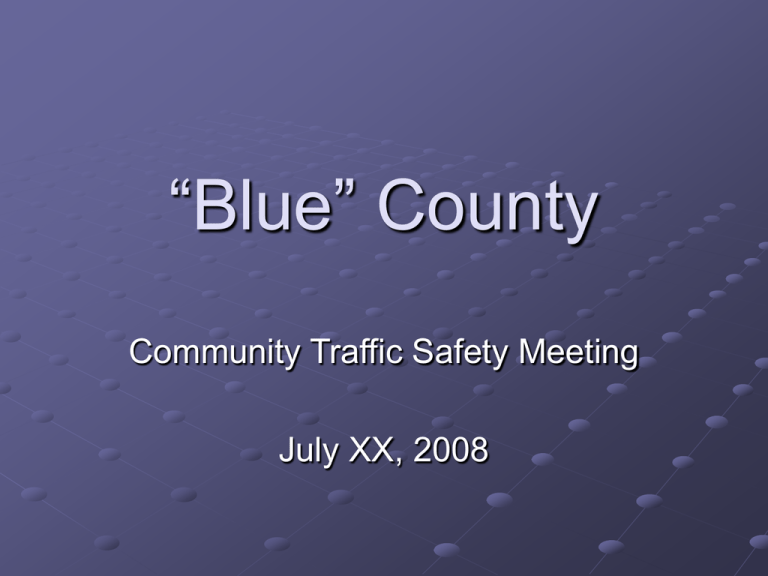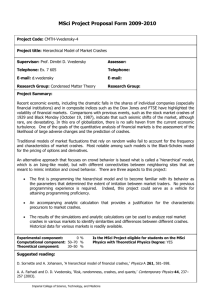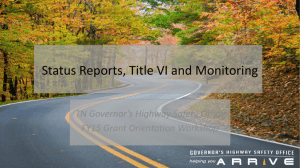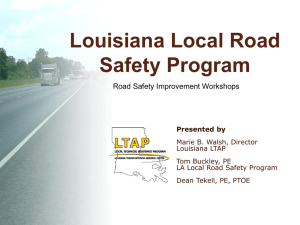Presentation - Minnesota Department of Transportation
advertisement

“Blue” County Community Traffic Safety Meeting July XX, 2008 Meeting Agenda Introductions Highway safety overview at the national and state level “Blue” County Crash Statistics SHSP and TZD efforts in MN Local safety initiatives Blue County Highway Department Local Law Enforcement Emergency Medical Services Education, Safe Communities, others present Summary and conclusions Next steps National Perspective The U.S. roadway system's positive trends have plateaued The number of annual roadway fatalities had remained virtually unchanged (40,000-42,000) In 2006, 42,642 people died in motor vehicle traffic crashes An average of 119 people died each day in motor vehicle crashes — one every 12 minutes. Economic impact of traffic crashes (2000) = $230.6 billion Persons Killed in Traffic Crashes 60,000 1,060 51,093 1,024 50,000 45,000 1,100 52,627 875 900 42,013 44,525 42,589 40,000 43,443 777 National 1,000 47,087 980 800 39,250 35,000 615 644 700 650 655 30,000 600 538 558 25,000 568 494 20,000 500 400 15,000 National 300 10,000 Minnesota 200 5,000 100 0 0 1965 1970 1975 1980 1985 1990 Year FIGURE 1.1 ANNUAL TRAFFIC FATALITY TOTALS NATIONALLY AND IN MINNESOTA 1995 2000 2005 Minnesota 55,000 1,200 Highway Safety in Minnesota In 2006 78,745 total traffic crashes reported 494 people died 35,025 people injured $1.5 billion estimated cost On an average day 216 crashes 1.4 deaths 96 people injured $4,190,169 daily cost 2006 Minnesota crashes 944 bicycle crashes 915 pedestrian crashes One-third of all crashes involved one vehicle 1 of every 3 fatalities was < 25 years of age 1 of every 11 fatalities was a SUV occupant 2 of 3 fatalities occurred in rural areas (< 5,000 pop.) Source: MN 2006 Crash Facts Figure 1.2 National and Minnesota Traffic Fatality Rates 657 Safety Goal All Others Critical Emphasis Areas Driver Safety Awareness A 19% Reduction in the Number of Traffic Fatalities 559 Ran-Off the Road 494 Head-On & Across Median Aggressive Drivers Young Drivers Signalized Intersections Unsignalized Intersections 500 400 Alcohol Related Unbelted 2002 Figure 1.3 Minnesota’s Statewide Safety Goal 2005 2006 2010 Goal The 2008 safety goal has already been achieved. Contributing factors in MN crashes Speed Failure to wear seat belts Drinking and driving Driver inattention Inexperienced younger drivers State of Minnesota Minnesota Strategic Highway Safety Plan (SHSP) Toward Zero Deaths Program (TZD) Minnesota Strategic Highway Safety Plan The MN SHSP is a cooperative effort by the MN Departments of Transportation and Public Safety VISION: To reduce fatal and life changing crashes on Minnesota roadways by aggressively implementing systematic and proactive safety strategies with an ultimate goal of moving Toward Zero Deaths Five Critical Emphasis Areas Increasing Seat Belt Use and Reducing Impaired Driving Improving the Design and Operation of Highway Intersections Lane Departure Reducing Head-On and Across Median Crashes Keeping Vehicles on the Roadway Minimizing the Consequence of Leaving the Roadway Young Drivers and Curbing Aggressive Driving Increasing Driver Safety Awareness, and Improving Information and Decision Support Systems Critical Strategies (Four E’s) Engineering Enforcement Education Emergency medical response and care 15 Critical Strategies Engineering Cost-effective safety improvements for lane departure and intersection crashes Assist local agencies in implementation of cost-effective improvements Maintenance of roadway facilities, roadside hardware, and removing hazardous objects Roadway Safety Audits at network level Enforcement Adequate resources to perform traffic enforcement Statewide primary seat belt law Automated enforcement (cameras) for red-light running and aggressive driving Stricter graduated licensing system Cooperation between courts and law enforcement to prevent reduced/eliminated charges Sobriety saturations and targeted enforcement Education Communications and marketing task force to raise public awareness Revise and enhance driver education Emergency Medical Response and Care Implement a statewide Trauma System Administrative Establish a Governor’s Traffic Safety panel Legislature Action Committee to lobby for GDL/improved curriculum/increased liability/ court involvement Adequate staffing, equipment and other resources for information systems Toward Zero Deaths (TZD) VISION: To reduce fatalities and injuries on Minnesota’s roads to zero. MISSION: To move the State of Minnesota toward zero traffic deaths on our roads through the application of engineering, enforcement, education, emergency services, research activities and community involvement. Blue County Crash Profile Purpose Analysis of crashes for five year period to identify locations with greater than expected numbers of fatal and injury crashes and to better understand the causes of and the solutions to these crashes Compare Blue County crash statistics to Minnesota State averages Cost of Motor Vehicle Crashes 20XX – Blue County Insert specific Blue County Data from DPS Crash Facts Report Crash Analysis Who is involved in these crashes? (M/F, age groups) What types of crashes are occurring? Fatal/Injury, ROR/Intersection/Rear end When are the crashes occurring? Time of day, day of week, monthly trend Where are crashes occurring? Road types or locations Why are crashes occurring? Known contributing factors (speed, alcohol, belts, inattentiveness) County Engineer Discuss safety initiatives Each discipline discuss safety initiatives Enforcement Emergency medical response and care Education - Safe community efforts or high school drivers education Local officials Others Discussion Is there a way we can work better together to improve traffic safety in our community? Next steps? Share Contact Information Thank you.




